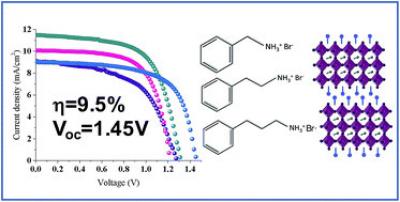Israeli researchers report on the high power conversion efficiency of bromide-based quasi 2D perovskite solar cells
A team of researchers from The Hebrew University of Jerusalem in Israel, led by Prof. Lioz Etgar, investigated the optical and physical properties of bromide quasi 2D perovskites synthesized using different barrier molecules. The team reports on the high power conversion efficiency (PCE) and high open circuit voltage (Voc) of bromide-based quasi 2D perovskite solar cells.

The various bromide quasi 2D perovskites were introduced into two PV cell configurations (with and without HTM). The use of the quasi 2D perovskite as an absorbing layer in PSCs reportedly yields improved efficiencies and open circuit voltage as compared to 3D PSCs. Different barriers in the quasi 2D structures have been shown to affect the photovoltaic performance; the cells' performance is reduced when increasing barrier length. However, the perovskite's hydrophilic character is suppressed with an increase in the chain length of the barrier molecule.

